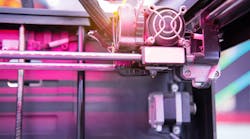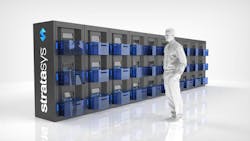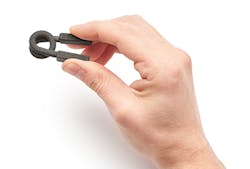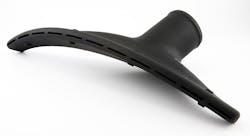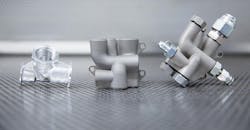3D printing has already been used in what can be considered mass production. Boeing is printing more than 200 parts into its planes, Airbus will be 3D printing in excess of 30 tons of parts a month next year, and GE has its Leap Engine. Recently, Stratasys and Formlabs produced machines that automatically replace the build platform in the companies’ respective printers. This can make 3D printing more attractive to larger volume batches.
Recent Machine Design articles have discussed how 3D printing is disrupting different markets, including automotive, aerospace, electronics, and gaming. And yes, it’s a fascinating time to see how far 3D printing will go, but the current technology isn’t capable of replacing traditional technologies. Ron Hawley, the chief science officer of Integrated Composite Products Inc. (ICP) offered the following example: “Imagine the first four-wheeler. It was probably made with a lot of metal. Its maker may have had access to a mill and some bending equipment, so it seems logical. However, as sales increase, you need to make things faster to keep up with demand. If milling a part takes 20 minutes, molding it with a thermoset might take five minutes. In this example, it wasn’t necessary to save weight or cost—it was imperative to fill orders.
“If you are making 200 thousand parts per year, however, it might not be possible to do so with thermosets,” he continued. “With the example above, you only have about 100,000 five-minute cycles in a year. “Thermoplastics are good for mass production. Quick manufacturing of thermoplastics can reduce hold and set times. Many parts are able to be molded in less a minute.”
3D printing can print complex parts, and in the last handful of years the materials that can be 3D printed has greatly expanded. However, when the demand reaches hundreds of thousands of parts, the faster process will always win. New technologies have been increasing 3D printing speeds. Hewlett-Packard’s Multi Jet Fusion Technology claims to print up to 10 times faster than other 3D printers. Carbon 3D has also claimed to print 10 times faster with the ability to print up to 100 times faster over time.
This will be great—and it’s already saving money on specific parts that went through an analysis, which determined that 3D printing would be the best course of action. But when you need to produce a part in under a minute which could easily be injection molded, 3D printing just isn’t there yet.
Senvol, a consultancy focused on 3D printing, has found ways to help close the gap and think of other ways 3D printing could better compete with traditional process. The firm has identified seven supply-chain scenarios that tend to lend themselves well to additive manufacturing. It uses these scenarios in an algorithm to show how 3D printing could increase value to companies in different ways.
- Expensive to manufacture: If complex geometry or high fixed costs leads to high prices, or production volumes are low, 3D printing might be the more cost-effective approach.
- Long lead times: If downtime costs are extremely high because of lead times on parts, 3D printing could offer a solution.
- High inventory costs: 3D printing allows for on-demand production, reducing the need for inventory.
- Sole-sourced suppliers: By qualifying parts for 3D printing, companies will no longer be as reliant on suppliers.
- Remote locations: When remote locations restrict delivery of parts, on-site 3D printing can eliminate delivery times.
- High import/export costs: On-site 3D printing production also eliminates high import/export cost.
- Improved functionality: 3D printing can redesign parts so that performance is improved, resulting in larger profit margins or market share.
To echo this, McKinsey and Company published an article discussing the five 3D printing disruptions that senior executives should prepare for.
- Accelerated product-development cycles
- New manufacturing strategies and footprints
- Shifting sources of profit
- New capabilities
- Disruptive competitors
3D printing has always been known to increase time between iterations, which can greatly reduce the time to market offering a company a competitive advantage. This advantage is bleeding into the end-use products.
Finding parts that have low volume, high value, high complexity, and/or high labor costs may have an advantage. For parts with high labor cost, 3D printing can reduce or eliminate assembly time, and automates the build process so labor overall is reduced. New features can be added into parts to improve performance or increase the parts’ value. In one study done by Formlabs the cost to make a part was reduced by over 40%.
One of the valuable features—and the third driver—was customization and personalization. 3D printing allows parts to be custom without adding cost. This could add new revenue streams to a company and mitigate workloads to market fluctuations, seasonal or otherwise. In many cases, adding safety warnings, part numbers, or instructions into parts avoids the process of adding stickers or decals on a part.
Understanding that 3D printing offers new capabilities might require a new way of designing. Where traditional processes might have been limited to shape due to ingot or casting limitations, 3D printing can take advantage of topographical optimization. Engineers need to start thinking in creative ways to fully utilize 3D printing. Multiple parts could be printed as one, interior passages can have complex geometries, and more. Engineers need to change the way they think if an end-use part could be 3D printed.
All of these benefits can help reduce the cost of entering a new revenue stream. It decreases time to market, provides molds, makes tooling for manufacturing, or even produces the end-use parts directly. McKinsey’s article mentions that new players could meet niche markets, custom parts, rapid delivery, or some hook to infiltrate the market. Overtime this might shift the competitive advantage from a company’s ability to produce high volume at low cost to one focused more on areas of the value chain. Until this happens, and as long as some parts need to be produced in seconds, 3D printing will continue to grow in multiple markets—but will not take over traditional process (yet).
